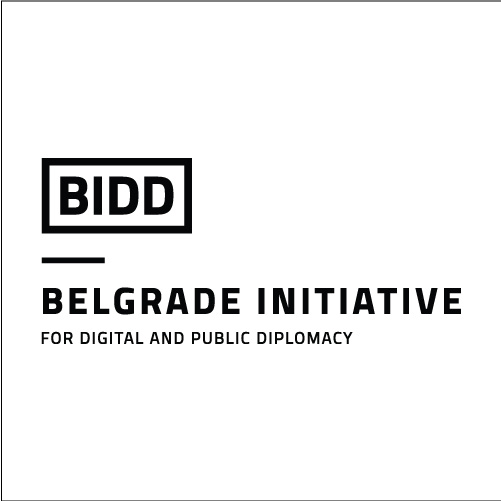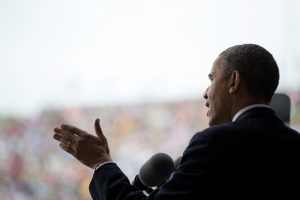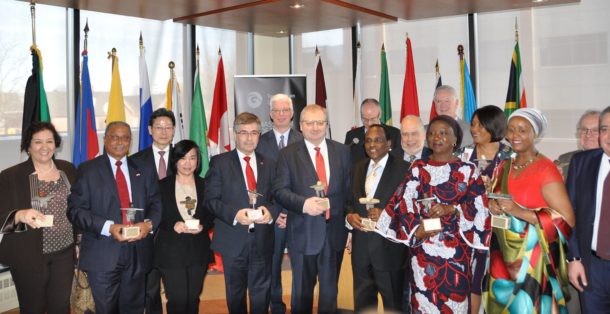TONY TAI-TING LIU, DEC 30 2018, International relations uncaptioned image from article
uncaptioned image from article
This is an advance preview from New Perspectives on China’s Relations with the World: National, Transnational and International (forthcoming 2019).
Since Joshua Kurlantzick (2007, 6) coined the term ‘charm offensive’ in 2007, the term has stuck in the study of International Relations to refer to China’s use of soft power to improve its global status and image. While the idea of China charming the world with its economic and cultural prowess has not changed too much over the past decade, the ways Beijing has adopted to charm other states have diversified since. In conjunction with such developments, in recent years, the term ‘public diplomacy’ has come to replace charm offensive as China’s latest efforts to improve its status and image through soft means.
Noting China’s recent turn towards public diplomacy, this chapter seeks to address the topic in three sections. Part one examines the idea of public diplomacy and corresponding developments that took place in China since former President Hu Jintao’s emphasis on the concept in 2009. Part two looks into the idea of ‘telling a good story of China’ – an important guiding principle of China’s public diplomacy – and corresponding efforts Beijing has made towards it. Part three discusses the Confucius Institute and China Cultural Centres and their contributions towards the goals of ‘telling a good story’ and fostering people-to-people relations. This chapter concludes with some considerations on the challenges China may face in its public diplomacy endeavour.From Peaceful Rise to Public DiplomacyDespite abundant discussions on ‘public diplomacy’ in the West, the concept remains quite refreshing in the context of China. In 2009, speaking on the occasion of the 11thConference of Chinese Diplomatic Envoys Stationed Abroad, Chinese President Hu Jintao expounded on the importance of public diplomacy in Chinese foreign policy. In Hu’s words, ‘[China] should strengthen public diplomacy and humanities diplomacy and commence various kinds of cultural exchange activities in order to disseminate China’s great culture’ (The 11th Conference of Chinese Diplomatic Envoys Stationed Abroad was held in Beijing, 2009). Hu’s address was significant, as the statement marked the first time China has considered the concept of public diplomacy on the level of national policy.Since then, public diplomacy gradually developed into a notable priority in the succeeding Xi Jinping administration. In the party report of the 18th National Congress of the CCP that was released in 2012 alongside the confirmation of Xi Jinping as China’s next president, Beijing clearly expressed the guideline of ‘making good efforts to advance public diplomacy’ (Xinhua 2012). In 2013, Xi Jinping followed up preceding calls for realising public diplomacy by introducing the corresponding concept of ‘telling a good story of China and disseminating the voice of China.’ ‘Telling a good story of China’ quickly became the central tenet of China’s public diplomacy.Under the state emphasis on public diplomacy, various public, private and academic institutions and organisations were established to carry out the function of reshaping China’s global image. In terms of government, the Public Diplomacy Office was established in 2009 as the main official body for managing and coordinating tasks related to public diplomacy on the state and departmental levels. In the private sector, echoing Beijing’s call for public diplomacy, a number of public diplomacy associations were subsequently established. In December 2012, the China Public Diplomacy Association was established in Beijing. The association serves as an informal channel for China to communicate with the world; the participation of academics and retired officials gives functions hosted by the association a track two or semi-official nature. On the regional level, 15 regional public diplomacy associations have been established across the nation in metropolitan centres such as Shanghai, Tianjin, Nanjing and Guangzhou (Han 2014). Academically, at least eight higher education and research institutes that focus on the study of public diplomacy were established across the country, including the Centre for Public Diplomacy at Tsinghua University (2011) and the School of International and Public Affairs at Jilin University (2013) among others.Institutional establishment aside, it is important to recognise that public diplomacy did not grow out of a vacuum in China but came about following a series of adjustments in Chinese foreign policy to cope with the so called ‘China threat theory’. In an essay in a 2005 issue of the influential Foreign Affairs magazine, Vice President of China’s Central Party School Zheng Bijian articulated in simple terms that China seeks a ‘peaceful rise’ and not otherwise (Zheng 2005, 20). Nonetheless, despite China’s peaceful intentions, as the term ‘rise’ also suggests the possibility of a powerful China becoming more assertive in international affairs, the term was eventually replaced with ‘development’ to suggest a less negative connotation. In the context of peaceful development, the Hu Jintao administration subsequently introduced the concept of ‘harmonious worldview’ and re-emphasised China’s good neighbour policy (Tsai et al. 2011, 27–30). China’s peaceful development, in other words, is realised through its emphasis on harmony.Public diplomacy as China’s new foreign policy emphasis came about in a similar vein. Following leadership turnover in 2013, Xi Jinping proposed the ‘China Dream’ as the new guiding concept for China in the near future. In Xi’s words, ‘China Dream is the great rejuvenation of the Chinese nation’ (Central Committee of the Communist Party of China Party Literature Research Office 2013). Unfortunately, Xi’s ideological calling provided little hints as to how China seeks to realise its rejuvenation or re-occupation of the centre stage of the world again. Such a void is perhaps covered by public diplomacy. In other words, in terms of the China Dream, part of how the Chinese nation will be rejuvenated rests with how well China conducts its public diplomacy, or an effort to improve China’s global image. In such a case, similar to related concepts introduced in the Hu Jintao era, the China Dream and public diplomacy are proposed as interconnected and mutually reinforcing concepts. Under Xi Jinping, the China Dream is the grand ideological principle that will guide China’s continued development in the near future while public diplomacy – similar to the ‘good neighbour policy’ – is one of the ways that Xi’s vision will be realised. Telling a Good Story of ChinaThe guiding principle for China’s public diplomacy drive is ‘telling a good story of China’ (讲好中国故事 jianghao zhongguo gushi), a guideline that has been repeated publicly by current Chinese President Xi Jinping since the 18th National Congress of the Chinese Communist Party (CCP). Noting the tendency of Chinese leaders since Jiang Zemin to pronounce their policy ambitions in short captivating phrases, ‘telling a good story of China’ is one of the latest notable phrases to follow in the string of announcements from the Three Represents to ‘scientific outlook on development’. While ‘telling a good story of China’ has attracted global attention in recent years; interestingly, the concept is not entirely new. In 2010, John Naisbitt – a renowned futurist who was well known for his earlier writings on Asia’s newly developed economies – together with Doris Naisbitt, published China’s Megatrends: The 8 Pillars of a New Society, a volume that detailed China’s rapid political, economic and social changes over the past two decades. The alleged idea for the volume, according to Naisbitt, came about through a conversation with ex-Chinese president Jiang Zemin in the 1990s, when Jiang invited him to tell a story of China (Ma 2009).Regardless of the reception of Naisbitt’s work, the idea of telling a good story became a foreign policy priority under Xi Jinping that is to be realised through various forms of public diplomacy. On 13 August 2013, in a speech given at the National Propaganda and Ideology Work Conference, Xi stressed the importance of establishing new forms of propaganda aimed at ‘telling a good story of China and disseminating the voice of China’ (Xi Jinping: Propaganda Work is an Extremely Important Task of the CCP, 2013). The 8/13 speech opened up the watershed for discussions on storytelling in China. While the political nature of Xi’s call is easy to notice, the statement nonetheless paved the way for various efforts towards defining and realising its content. Among the discussions, Wang Yiwei’s interpretation of telling a good story of China is worth noting:As Party Secretary Xi Jinping pointed out, the quest of the era is to tell the story of China and the mission of the era is telling a good story of China… first is to tell the development story of China and the ideals that support China’s development… telling a good story of China means telling a good story of oneself and projecting the attraction of China through personal appeal… the story of China is multifaceted; there is success and there is also failure. The key is to tell the Chinese way or approach behind the story (Wang 2016).Wang’s description highlights three components to China’s guideline that warrant attention. First, the story of China is about development, with economic development serving as the mainstay of the story. Second, the story of China is about the individual; individual success stories help to shape and project China’s global image. Third, the story of China is a mixed success story; the Chinese experience or how China succeeded should be part of the story. Realised through public diplomacy, China’s storytelling aspiration – an effort to improve the Chinese image abroad – has notably taken several forms since 2013.In terms of development, not long after the 8/13 speech, Xi Jinping proposed the Belt and Road (B&R) initiative, an ambitious geopolitical project that seeks to integrate Asia, Europe and Africa into an intercontinental market and transport network. Alongside the B&R, the Silk Road Fund (SRF) and the Asia Infrastructure Investment Bank (AIIB) were subsequently established to finance the project. Jointly, the B&R, SRF and AIIB aim to improve trade and transport routes – channels that are facilitated by infrastructural development – around the world. Based on the integration and investment initiatives, Xi Jinping has expounded on the theme of development, most notably at the 2016 G20 Summit in Hangzhou, where he delivered a speech titled ‘A New Starting Point for China’s Development: A New Blueprint for Global Growth’ (Keynote Speech by H.E. Xi Jinping, President of the People’s Republic of China, at the Opening Ceremony of the G20 Summit, 2016) and at the 2017 Belt and Road Summit in Beijing, where Xi referred to China’s historical connection with the Silk Road and elaborated on themes including economic, infrastructure, innovation and green development (Full text of President Xi’s speech at opening of Belt and Road Forum, 2017). In addition, the Chinese government has invested great efforts in promoting the B&R through various methods, which includes the publication of the B&R Public Diplomacy Report (2016), the production of a major documentary series on the B&R (2016), and the release of a project theme song just ahead of the B&R Summit (2017).On the other hand, regarding individuals, examples may be gleaned from the variety of ways through which China and the Chinese are presented. Concerning the B&R, such presentation can be observed from the frequent reference by the state to Zhang Qian and Zheng He, historical figures in China’s ancient past who are regarded as the trailblazers for what came to be known as the Silk Road and China’s maritime trade route respectively. Emphasis on the individual can also be observed from the B&R documentary series produced by China Central Television (CCTV), China’s official broadcasting service. Besides interviews with influential figures and experts, the documentary is interwoven with the personal stories of some 60 common individuals who dwell along the B&R (CCTV 2016). Finally, China is represented by its political and business elites, or individuals who receive media attention internationally. Such an approach is exemplified by the so-called ‘head of state diplomacy’ that sees Chinese leaders promoting China’s national image abroad. Since assuming the role of China’s top leader in 2013, Xi Jinping has made official visits to more than a dozen states annually, consolidating China’s foreign relations while gathering international spotlight on China through wide media coverage and reporting.Tools of Public Diplomacy: Confucius Institute and China Cultural CentreAlthough public diplomacy did not begin to take the form of official policy until 2013, the Chinese leadership had similar ideas in mind nearly a decade earlier. Under the Hu Jintao administration, the Confucius Institute, a state sponsored institution with the objective of teaching and promoting the learning of the Chinese language abroad, was established under Confucius Institute Headquarters, also known as the Hanban, in 2004. The Hanban is responsible for overseeing the operation of the global network of Confucius Institutes across the world. Amidst incessant discussions on China rising onto the world stage as a revisionist threat, the Confucius Institute was envisioned by Beijing as a way to reduce the anxieties surrounding China while promoting China’s image as a benevolent and peaceful power abroad. Soft power, a term coined by political scientist Joseph Nye (2005), was the keyword associated with the Confucius Institute and China’s adoption of soft means to improve its global image then.Since the establishment of the first Confucius Institute in Korea in 2004, the number of China’s language teaching institution grew rapidly. By the end of 2016, China had established 512 Confucian Institutes and 1073 Confucian Classrooms (programs established in high schools and primary schools) in more than 140 countries around the world (Hanban 2017). While the Confucius Institute is primarily a language teaching institution, it is inevitable that its curriculum and textbooks used in classrooms are infused with lessons and stories on Chinese history and culture. In such a sense, the Confucius Institute fits well with the guideline of ‘telling a good story of China’ and the objectives of China’s public diplomacy. Meanwhile, through the organisation of cultural celebration events and language competitions, the Confucius Institute also enhances people-to-people relations through the direct interaction between foreign and Chinese participants and organisers. The annual ‘Chinese Bridge’ Chinese Proficiency Competition is a good example of the Confucius Institute’s public diplomacy achievement. Through the organisation of language competitions across the world, China has not only provided a motivation for foreign students to study Chinese but also sparked the interest of students to visit China (Hui and Wang 2015, 301). Such efforts are expended in the hopes of fostering a future generation of individuals with an improved image of China.On the other hand, China has also established cultural centres across the world as a way to promote Chinese culture beyond classrooms. Since the first establishment of China Cultural Centres in Benin and Mauritius in 1988, more than 20 cultural centres have been established in Asia, Africa, Europe, Oceania and Central America, with most of the additional locations introduced after 2000. China currently hosts 27 international cultural centres, with a large number of the centres spread out across Asia and Europe. As described in its online introduction, the China Cultural Centre organises cultural activities such as performances, exhibitions and art festivals and provides Chinese language and cultural training courses (China Cultural Centre 2015). In terms of public diplomacy, the China Cultural Centre plays no small role in disseminating knowledge on China through the constant organisation of musical performances and art and calligraphy exhibitions and events among others. Meanwhile, in 2012, China’s Ministry of Culture introduced ‘Happy Chinese New Year’ (HCNY) (欢乐中国 huanle zhongguo), a series of cultural festivities centred on the theme of Chinese New Year. Adopting the central tenet of ‘happiness, harmony, dialogue and sharing’, the HCNY celebrations seek to tell a story of China that is robust and cherishes communal values, which stands in stark contrast with arguments that deem China as a colossal threat (China Cultural Centre 2017).Prospects of China’s Public DiplomacyThis chapter provides a short survey of the development of China’s public diplomacy in recent years and some efforts Beijing has expended towards the improvement of its global image. While it is much too early to evaluate the success of China’s new charm offensive, previous experiments with soft power by Beijing present several challenges that China may need to address if it hopes to find success with public diplomacy.First, while China provides a definition of ‘public diplomacy’ in its official public diplomacy report, to some extent, the definition remains excessively general and difficult to translate into real policies. While an optimistic reading of China’s definition suggests the inclusion of ‘governments, non-governmental organizations and individuals’ is a non-discriminatory act that seeks to exploit the full strength of the nation in realising public diplomacy, an alternative reading raises the question of whether there exists a one size fits all policy guideline for all the actors. After all, diplomacy is traditionally limited to the realm of the state; to move diplomacy outside the state may require policymakers to think outside the box, as private and non-governmental actors may harbour widely different interpretations of the state and its various features. In other words, China is viewed differently across different levels and sectors and narratives may contradict – the success story of one may have nothing to recommend for another. Such challenge warrants attention if China seeks to claim further success with public diplomacy.Second, the fact that China remains an authoritative regime generates contradictions with the concept of public diplomacy that are hard to resolve. Even though public diplomacy can be considered an interest driven action regardless of regime type, China’s authoritative character exacerbates the issue by hinting at the potential involvement of sophisticated consequences. For example, by enshrining the guideline of ‘telling a good story of China and disseminating the voice of China’ as propaganda, China proposes a dilemma between the nature of the Chinese regime and public diplomacy. If public diplomacy is guided by the principle of disseminating propaganda, how credible are China’s foreign policy communications and actions? Indeed, such tensions have been raised in the past concerning the Confucius Institute. As critics point out, under its disguise to pass on knowledge of Chinese language and culture to the outside world, the Confucius Institute also encourages students to think highly of China and its ruling political authority (Peterson 2017). While such claims remain controversial and rebuffed by China, backlashes have occurred, with institutions such as the University of Chicago and Pennsylvania State University terminating their cooperation with the Confucius Institute and many other institutions around the world becoming more vigilant over China’s public diplomacy (Liu 2017). As the case of the Confucius Institute demonstrates, trust remains a crucial ingredient for the success of China’s language teaching institutes abroad and ultimately, China’s public diplomacy. How Beijing seeks to increase the world’s trust in China in the near future remains to be observed.ReferencesCentral Committee of the Communist Party of China Party Literature Research Office. 2013. Xijinping guanyu shixian zhonghua minzu weida fuxing de zhongguomeng lunshu zhaibian (Summary of Xi Jinping’s Discourse on Realizing the China Dream and the Great Rejuvenation of the Chinese Nation). Beijing: CCCPC Party Literature Research Office.CCTV. 2016. “Daxing jilupian yidaiyilu zai yangshi kaibo” (Major Documentary “Belt and Road” Aired on CCTV). http://www.cctv.cn/2016/09/05/ARTIpI1WmImwT3VSoDvU7Rye160905.shtmlChina Cultural Centre. 2015. “About China Cultural Centre,” http://en.chinaculture.org/ccc/2015-02/02/content_597924.htmChina Cultural Centre. 2017. “Huanle zhongguo” (Happy Chinese New Year), http://cn.chinaculture.org/portal/site/wenhua/special_report/springfestival/2017/index.jsp#imglistbox“Di shiyi ci zhuwaishijie huiyi zaijin zhaokai” (The 11th Conference of Chinese Diplomatic Envoys Stationed Abroad was held in Beijing). 2009. People’s Daily, July 21.“Full text of President Xi’s speech at opening of Belt and Road Forum.” 2017. Xinhua News, May 14. http://news.xinhuanet.com/english/2017-05/14/c_136282982.htmHan, F. 2014. “Shibada hou zhongguo gonggong waijiao shiye de fazhan” (The Development of China’s Public Diplomacy after the 18th National Congress of the CCP). http://blog.ifeng.com/article/31833706.html&gws_rd=cr&ei=mg4zWe_qEcKz0gTHxorADAHanban. 2017. “Guanyu kongzi xueyuan ketang” (About the Confucius Institute/Classroom). http://www.hanban.org/confuciousinstitutes/node_10961.htmHui, C. and Wang, B. 2015. “Dunzi yiwenhuiyou yiyoufuren – kongzi xueyuan shizhounian fazhan jieshao” (Ten Years Development of the Confucius Institute: An Introduction), in Zhao Qizheng and Lei Weizhen eds., Bluebook of Public Diplomacy: Annual Report on China’s Public Diplomacy Development. Hong Kong: Peace Book, 293-301.“Keynote Speech by H.E. Xi Jinping, President of the People’s Republic of China, at the Opening Ceremony of the G20 Summit.” 2016. http://www.g20chn.org/English/Dynamic/201609/t20160909_3414.htmlKurlantzick, J. 2007. Charm Offensive: How China’s Soft Power is Transforming the World. New Haven and London: Yale University Press.Liu, T. 2017. “Exporting Culture: the Confucius Institute and China’s Smart Power Strategy,” in David O’Brien, Toby Miller and Victoria Durrer eds., The Routledge Handbook of Global Culture Policy. New York: Routledge.Ma, C. 2009. “Tell a big story well to sell it to the world.” China Daily, September 8. http://www.chinadaily.com.cn/cndy/2009-09/08/content_8664887.htmNye, J. 2005. “The Rise of China’s Soft Power.” Wall Street Journal Asia, December 29. http://www.belfercenter.org/publication/rise-chinas-soft-powerPeterson, R. 2017. “American Universities are Welcoming China’s Trojan Horse.” Foreign Policy, May 9. http://foreignpolicy.com/2017/05/09/american-universities-are-welcoming-chinas-trojan-horse-confucius-institutes/Tsai, T., Hung, M. and Liu, T. 2011. “China’s Foreign Policy in Southeast Asia: Harmonious Worldview and Its Impact on Good Neighbor Diplomacy.” Journal of Contemporary Eastern Asia 10 (1), 27–30.Wang, Y. 2016. “Jianghao zhongguo gushi shi shidai shiming” (Telling a Good Story of China is the Mission of an Era). People’s Daily, September 28. http://theory.people.com.cn/BIG5/n1/2016/0928/c376186-28746111.html“Xi jinping: yishi xingtai gongzuo shi dang de yixiang jiduan zhongyao de gongzuo” (Xi Jinping: Propaganda Work is an Extremely Important Task of the CCP). Xinhua News, August 20, 2013. http://news.xinhuanet.com/politics/2013-08/20/c_117021464.htmXinhua News. 2012. “Shibada baogao quanwen” (Full Text of the Party Report of the 18th National Congress). November 19. http://www.xj.xinhuanet.com/2012-11/19/c_113722546_11.htmZhao, Q. and Lei, W. eds. 2015. Bluebook of Public Diplomacy: Annual Report on China’s Public Diplomacy Development. Hong Kong: Peace Book.Zheng, B. 2005. “China’s ‘Peaceful Rise’ to Great-Power Status.” Foreign Affairs, 84 (5), 18–24.Original Article
Public diplomacy John Brown's Public Diplomacy Press and Blog Review Public Diplomacy: China’s Newest Charm Offensive







